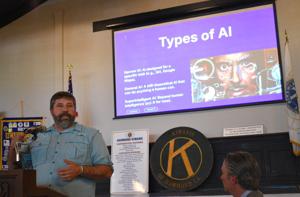Richard Silewicz gave an introductory explanation on artificial intelligence to the Hammond Kiwanis Club at their Tuesday meeting. Silewicz works as technical director for the City of Hammond, described in his introduction at the meeting as having his phone often “glued to his ear.” Because what is considered AI is so broad, Silewicz decided to provide a basis for Kiwanians to start with.
This range of information included definitions of AI, how it’s used in different aspects of life and the positives and negatives of its existence and continuing development. Silewicz said that AI is like “teaching a child what is a dog.” Similarly to how one would show pictures of dogs or introduce their kids to them in real life, AI is fed data by people, and from that data it learns.

He continued that AI relies on algorithms and data in order to work, meaning it can be wrong or have false information if fed incorrect data, hence why it should be considered a tool and not a replacement. Silewicz said, for example, that he uses it in his job to help summarize emails he received or to send difficult emails, but he double checks them because they’re bound to include a few mistakes. He explained the multiple types of AI, such as narrow AI and general AI.
“Narrow” refers to applications like Siri or Google Assistant which perform specific tasks. General AI concerns “in-theory” technology like the digital Jarvis from Marvel’s “Iron Man,” that could take commands like ordering a car or starting dinner. He broached the concept of Super Intelligent AI but said that the technology is not there yet, in terms of making decisions for a person.
Silcewiz touched on machine-learning types, a subset of AI that learns over time from data and neural networks that are modeled after the human brain, with interconnecting nodes. Silewicz described the ways that AI has made its way seemingly into almost every aspect of people’s lives. AI is used by hospitals to better detect diseases, by businesses like Amazon to take in data to better advertise to each individual customer, by transportation businesses developing self-driving cars, by entertainment industries for features like Netflix suggestions, to create customer service chatbots and in finance and air travel.
Artificial intelligence even neutralized an infiltrated network one time as Silewicz was grabbing his laptop to do that exact task. He said he is always worried that someone is trying to get into the networks he supports, but with AI, he might be able to sleep better at night. While he listed some of the positives of AI, like making jobs more efficient, there are plenty of downsides – in education for example.
“As a former teacher, I’m glad I’m not in education. Why? Because of AI,” Silewicz said. That’s due to the easy access AI allows for students to put in no work on projects or papers and to instead type in a simple prompt to AI sites like ChatGPT.
There are also instances of hackers utilizing AI to further breach networks and create programs. Silewicz ended his presentation by asking ChatGPT how to make a crawfish boil, to test the accuracy the data it was receiving. The AI broke down the recipe and directions for each part of the boil including purging the crawfish, setting up the boil, cooking the extras and the timing.
Afterward, Silewicz responded to questions and statements made by Kiwanians regarding their experiences with AI. He left Kiwanians with this message: “You’re not going to outrun it. Embrace it; use it as a tool to make your lives easier, to make yourself more efficient.
”.
Top

Kiwanians learn about AI

Richard Silewicz gave an introductory explanation on artificial intelligence to the Hammond Kiwanis Club at their Tuesday meeting.











